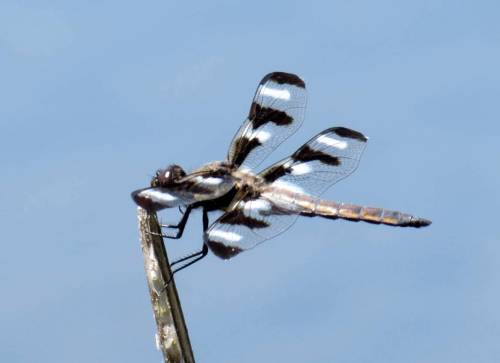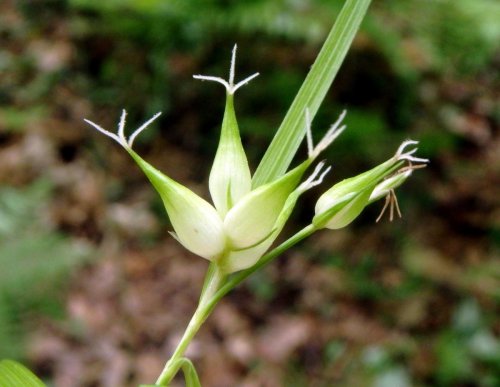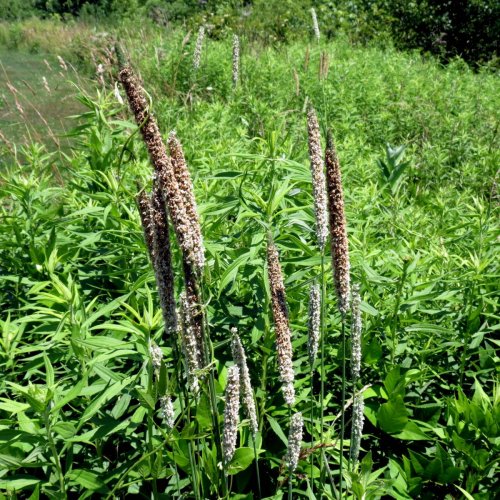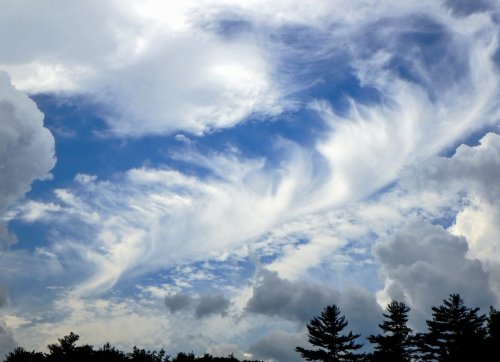Our hot dry weather continues, and the more visible stones there are in the Ashuelot River the lower the water. This is normal in the in late July and August, but it has been this way since May, and that isn’t normal. Or maybe it’s the new normal.
Despite the low water levels I’m seeing a lot of dragonflies, like this 12 spotted skimmer. Males are sometimes called 10 spotted skimmers, but apparently it depends on whether you count the white spots or brown spots. Only males have white spots between the brown. I’ve read that mature males seldom perch, but this one returned to its twig again and again.
I’m not sure about the identity of this dragonfly, but it might be a dusky club tail. There is a similar dragonfly called the ashy club tail though, and I’ve read that care needs to be taken in identification of the two. Since I have no field guides that are very helpful for dragonflies I’ll leave it up to those more knowledgeable than I to make an identification, if they care to. Males of both species have blue gray eyes and very similar markings and colorblindness keeps me from seeing any obvious differences.
The widow skimmer is another common dragonfly with brown and white wing patches, but only males have the white markings. One day it seemed like hundreds of them flew at a local pond and that is a good thing, because they eat mosquitoes.
I’m not sure what was going on here; either an ant and a spider were fighting or an ant was carrying a big striped egg. Whatever was going on it was all taking place on a Queen Anne’s lace flower head.
There have been times when butterflies literally landed at my feet on various trails but so far this year I can’t get near them. This one did sit still for more than a few seconds though, so I was able to get a poor shot of it. I think it’s a white admiral.
I saw these strange little pencil eraser size brown things on a log recently. They were small enough so I had to use my camera to see the details and when I did I realized they were the chocolate tube slime mold (Stemenitis) that I had been hoping to see for a very long time.
Chocolate tube slime molds get their common name from their long brown sporangia, which stand at the top of thin black, horsehair like stalks. They typically grow in clusters on rotting wood and are found on every continent on earth except Antarctica. They are also called “pipe cleaner slime molds” or “tree hair.” There are thought to be about 18 species which can only be accurately identified with a microscope. Some can be quite long and look like sea anemones, but these examples were short; about a half inch long. They start life as a white plasmodial mass before becoming a cluster of small yellow bumps, and they in turn grow into what you see here.
Once its spores have been released the chocolate tube slime mold kind of melts away, and this is what is left.
I saw a good example of scrambled egg slime mold (Fuligo septica) on another log. This common slime mold grows in full sun on logs, wood mulch or wood chips and is easily seen because it can get quite large. It also produces the largest spore producing structure of any known slime mold. At the stage shown the slime mold has formed a crust and before long it will darken in color and begin to release its spores.
Porcupine sedge (Carex hystericina) is blossoming. This common sedge is also called bottlebrush sedge and I usually find it on the shores of ponds or in wet ditches.
The flowers of porcupine sedge are so small they are almost microscopic, but you can see them here. They are the whitish wisps that appear at the ends of the spiky protrusions, which are called perigynia. Waterfowl and other birds love its seeds.
Another sedge that was flowering recently was this bladder sedge (Carex intumescens.) The wispy white flowers look like those on porcupine sedge but these are larger and easier to see. This is another sedge I find on pond edges and wet places. I thinks it’s one of the prettier sedges.
I think anyone who has spent much time on a riverbank or pond shore has seen brown wooly sedge (Scirpus cyperinus,) but I can’t remember ever seeing it flowering before like it’s doing here. It is also called cotton grass bulrush, I’d guess because of the cottony look of its many white flowers. This is a big, clumping sedge with three foot tall flower spikes but the flowers are so small I couldn’t even get a useable photo of them. In time these tiny flowers become even fuzzier and look more cottony than they do in this photo.
I hope everyone takes the time to look at grasses because some can be quite beautiful when they flower. The latest one I saw blossoming was this Timothy grass (Phleum pretense.) This well-known grass was brought to North America by early settlers and was first found in New Hampshire in 1711 by John Hurd. A farmer named Timothy Hanson began promoting cultivation of it as a hay crop about 1720 and the grass has carried his name ever since.
Timothy grass flowers from June until September and is noted for its cold and drought resistance. It’s an excellent hay crop for horses. Each tall flower head is filled with tiny florets, each one with three purple stamens and two wispy white stigmas. The flower heads often look purple when they are flowering.
An oak tree came up in deep shade and decided it didn’t need to photosynthesize, since it never saw any sunshine. It might grow on but I doubt it will last long unless an older tree falls and opens up a hole in the canopy.
You see lots of photos of the fuzzy red berries of staghorn sumac (Rhus typhina) but you never see the flowers that the berries come from, so I like to show them now and then. The big green flower heads were just coming into bloom when I took this photo.
The small, yellow-green, five petaled, fuzzy flowers will never win any prizes at a flower show but they’re interesting and always remind me of poison ivy flowers, even though they aren’t poisonous.
Many people forage for and eat (or drink) the fuzzy red berries of staghorn sumac just as Native Americans did. This year there will be plenty because, as this photo shows, the birds have hardly touched them. I’ve read that the berries “yield a fine claret colored spice that is deliciously tart and clean tasting.” I’ve heard they taste like lemon, and I know that a drink that could easily pass for lemonade can be made with them. They are said to be very high in vitamins C and A. In Europe a different sumac, Rhus coriraria, is used in much the same way. Why the birds don’t eat the berries like they do in other parts of the country is a mystery to me.
Sarsaparilla plants are interesting at all times of year. In spring their leaves appear in threes at the top of thin stalks and quickly turn to shiny bronze. In summer they display patterns made by leaf miners, and in late summer when I don’t want to think about fall yet they are among the first leaves in the understory to turn yellow. I have a hard time imagining an insect so small it can eat its way between the top and bottom surfaces of a leaf but the patterns they make can be interesting.
I was mowing one afternoon quite far from any shelter when these clouds decided that a 20 minute, torrential downpour would be fun. Luckily I found a place where I could stay relatively dry and when the storm broke mare’s tail clouds formed as I watched. Mare’s tails are a type of cirrus cloud known as cirrus uncinus, which means “curly hooks” in Latin. When they appear with altocumulus clouds they often mean that a storm is brewing. I should have been paying attention to their message before the rainstorm.
It’s not what you look at that matters, it’s what you see. ~Henry David Thoreau
Thanks for stopping in.
































